| |
"For me it was Seventh Voyage of Sinbad. I just went ape-shit, and I came home so excited. I mean, a Cyclops and a dragon; the whole thing. I said to my mom, 'Who does that? Who makes the movie?' And she said 'The director. He makes the movie.' So from the time I was eight years old, my only advantage was that I knew what I wanted to be when I grew up." |
| |
Director John Landis describing every film nut's epiphany!* |
I was ten! Every passionate film aficionado can pinpoint when the seed was sown and when it took root. So powerful was cinema in the lives of certain people of a certain generation that it became part of the way you thought, communicated and expressed your own personality. Nowadays screen fodder (disrespect intended – at the way we consume cinema, not cinema itself) doesn't seem to be held in the same reverence and perhaps that's also due to the nature of modern cinema and the digital crossover. The idea of practically having to create a physical object to commit to film may be becoming a lost art. It's knowing this, many decades ago, which reinforced my reverence for cinema. We knew how hard it was especially when it came to special effects. Yes, there are still filmmakers out there hanging on to that art while using computer-generated imagery to help composite said practical objects. But while CG artists are as much craftspeople and artisans in their own right (and their craft has developed at an amazing speed and now in 2019 it's cumulatively more than astonishing), there's something rather dismissive about watching movies these days. I still contain vestiges of that original wonder and awe, but it's being slowly chipped away by a general insouciance, a detachment partnered with a flick of the wrist and a muttered "It's just CGI..." Sixteen years after John Landis' horror movie (with laughs, scares and stunning practical transformation effects) came its sequel, An American Werewolf in Paris. Sixteen years. In sixteen years techniques can improve in leaps and bounds. Problem was, the new kid on the block was getting all the attention. Practical effects edged off the stage to make way for their brash new competitor, computer generated effects. Wow! Well, the early days of any technique are fraught with pitfalls. With the exceptions of some close ups, most of the sequel's wolf-work was achieved with a nascent CG technology that today looks horribly risible. It elevates the original by virtue of it being badly written, preposterous of plot and with effects (alas) that made you look at your fellow audience members as if you'd just seen a goalkeeper slam into a post, genitals first (or sucked on a lemon or both). A lemon it was. But the original... Oh boy. That's another story.
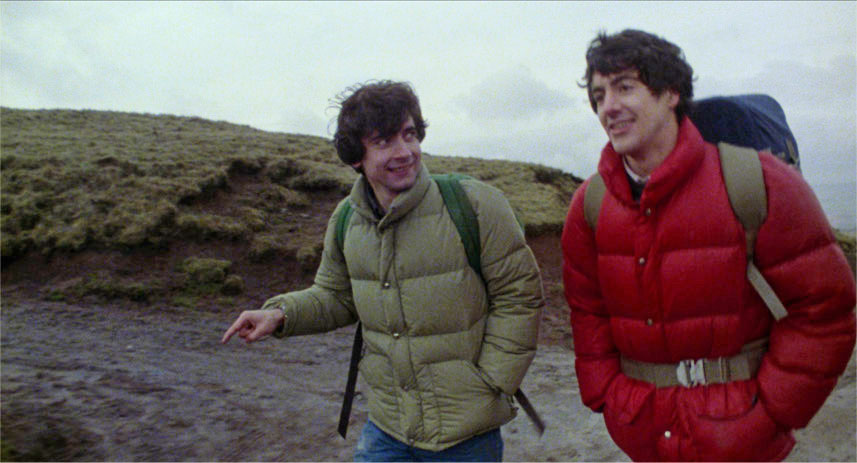
Suitably horrific, and very funny, An American Werewolf In London ticks many genre boxes and some at the same time. It presents the idea of the werewolf myth as a straightforward, albeit shocking reality. Someone infected with the virus of lycanthropy can pass it on through blood via a bite. As a wolf, a wild creature, the victim acts only from instinct even though from a real wolf's point of view, it would never attack human beings. Don't get me started on that one. But we all know werewolves are potent and effective monsters. What would be the point of a transformation without the subsequent threat? Well, portents of doom don't get much more on the nose than the first time we meet our young American backpackers, David and Jack, fishes firmly out of water. They've been given a ride by a local farmer in the back of a truck with all the other sheep. And as if that's not enough signposting, their first port of call is a pub called The Slaughtered Lamb. I'd say they were in some looming and significant danger. After the Western cliché of entering a bar and have everyone stop and stare, the boys settle down for some warmth, potential cups of tea and the cosy atmosphere of a small xenophobic community living in palpable fear. Seeing a sign that Jack remembers from an old monster movie, the sign of the werewolf, he asks the locals "What's that star on the wall for?" Silence. The 'chunk' of a missed dart. "You made me miss," says the darts player. Unwelcome the boys leave but there's a terrible sense of dread. The pub villagers know something but they still let the boys go anyway with a warning to stay on the road. The demonic howling begins. It doesn't take too long before the boys have indeed wandered off the road (whenever I see that shot, I shout at the screen "Stay on the fecking road!") Maybe I never noticed them veering off the road the first time I saw this movie but it has successfully bugged me every subsequent viewing and trust me, there have been a lot. "Oops," says David. Right. More of a "Jesus Christ," given the darkness and what we know is coming. Bang! David and Jack are attacked on the moor by a fast cut (no irony there), furry, toothy creature that rips Jack to pieces and bites David before being noisily despatched by informed but scared locals. David wakes up in hospital and if you've not seen this film, I will say no more. The pleasure and terror of American Werewolf is yours to savour, spoiler free. So now I'd like to concentrate on aspects of its finely judged appeal.
Director/writer John Landis wrote the screenplay when he was eighteen. Now my sentence after that would probably imply some sense of impressed surprise or an affirmation of its naiveté, one or the other. In truth, from my point of view, it's a mixture of both, a happy accident with charming and smart ad-libbing actors and a cast that just fit the enterprise so perfectly, the film seems as if it has always existed. Considering we are dealing with werewolves, everyone, (almost including Young Ones star Rik Mayall at the bar at the start) plays it absolutely straight. The only people who know all this shit is real is us. The comedy is never at the horror's expense and is simply borne from character interactions. The dialogue of both David and Jack just before the attack is so believable. Have you ever asked yourself how would you handle a life-threatening situation even if it was (especially if it was) impossible by your normal understanding of the world? Would you be an in-denial Hudson from Aliens, "This can't be happening man! This isn't happening!" or would you be prepared to see what was in front of you and deal with the situation? American Werewolf very cleverly allows the belief that werewolves are not real from certain characters' points of view as a thread throughout. It's only the climax that David's concerned doctor and his anguished lover are 'allowed' to accept the reality of the situation however monstrous and unbelievable. So, how do you present a film with the supernatural subject of lycanthropy made real and convince an audience to care? Easy. Make An American Werewolf in London. David's relationship with Alex (Nurse Price) despite conveniently happening at warp speed, the fantasy of an eighteen-year-old boy no doubt, is actually believable. We care about both David and Alex despite the total absurdity of their situation. When actors commit and are believable, we almost have no choice but to commit with them. It's not front-page news that every Jaws fan could easily pull apart the fake shark, Bruce, in terms of believability. But as Quint slides to his doom, Shaw's commitment is enough to terrify and thrill us.
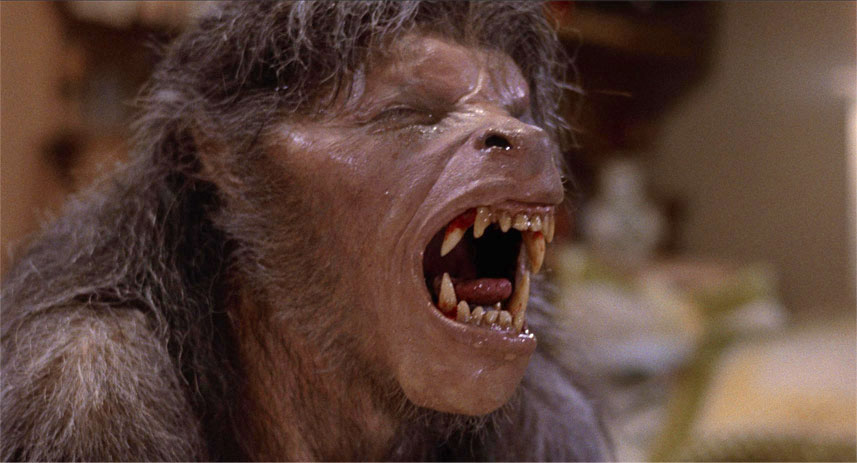
There seems to be little point in praising make-up wizard Rick Baker for his transformation scene and gory make-up. His 'Wow!' in-box must be stuffed to the gills by now. But at the time I can attest to how shocking and groundbreaking it really was. What I like about the eventual creature most of all is it's head. It looks terrifying and is a very effective movie monster. For years I was completely taken in on how they achieved the shots of it stalking through Piccadilly Circus. I'll let the extras take care of that information for you. I was heartened to hear that if Rick Baker had a small problem once they'd wrapped filming the transformation sequence, that it was the same problem I had. David flips over revealing a full body werewolf-to-be prosthetic model. Considering the care taken over all other shots of the body growing hair and mutating in front of our eyes, the lower legs and feet of the full body prosthetic do not look like truly organic body parts as they 'bounce' which is not a good look (which is why the shot is relatively short). Baker confirms in Beware The Moon, Paul Davis' main extra feature, that the movement he really wanted was what happened as the prosthetic had its control rods taken out. But the crew had wrapped by then.
You cannot tell an effective horror story without a first class cast taking it seriously. The two boys are great fun, believable and David ends up saying and doing exactly what most of us would in the same bizarre situation. Naughton and Dunne, though young and inexperienced, are perfect in their roles. Jenny Agutter was a friend of John Landis' and not usually a horror fan but it was her friend's script so she agreed to play Alex. Agutter is the beating heart of the movie. Her final scene... No spoilers. Anchoring reason and evidence and playing essentially the audience is John Woodvine playing Doctor Hirsch, a reassuring presence whose every scene is a delight. I particularly like his little finger movements dealing with Guinness froth on his upper lip. David Schofield is the darts player with the memorable lines. A regular on UK TV, he's most recognisable to me as a senator in Gladiator. Stay to the end credits for the best story of the disc from the actor in Beware The Moon. Brian Glover steals the scenes he's in but despite his fame as the go-to Northerner, he still skilfully manages to convey the unease and fear knowing about something that should not be but is. You may spot Indiana Jones and Superman at the wheel of the double decker in the climax. That's Vic Armstrong who doubled for both iconic characters in a long career as a stuntman. Finally I must mention an actor that I've worked with and in the film I worked on, he played practically the same character, the guy who delivers the stars to where they need to be. Take a nod, first billed in the end credits, Joe Belcher. The film is full of memorable moments, some scripted, some not. It's a tiny thing but I love the fact it was kept in. The policeman runs out of the porno cinema terrified and jumps up to bring the metal shutters down trapping the beast. But on his first jump he misses. Moments like that in movies make me so happy. Oh, and I almost forgot to mention Paul Kember who plays the delightfully awkward and accident prone Sergeant McManus. It takes some real skill to be this socially inept. It's said somewhere on this disc that the two detectives were based on Laurel and Hardy. Pretty sure Oli never got his head bitten off but I guess we can take comparisons a little far.
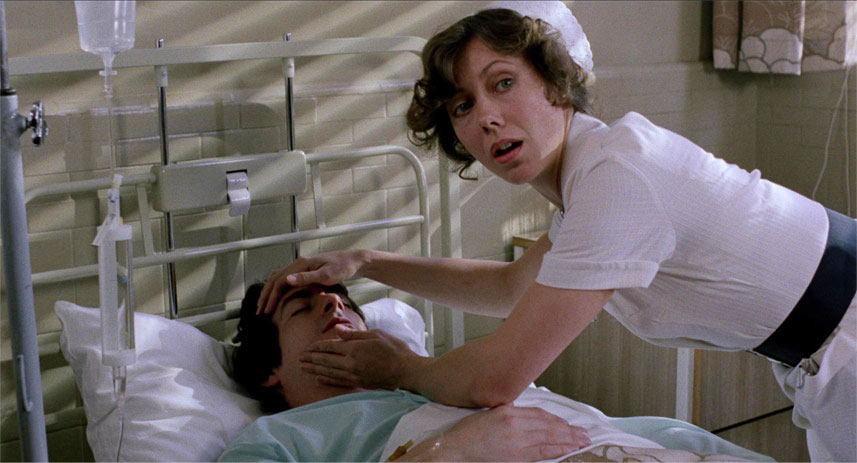
To nit pick (if I must)... How did an injured and unconscious David get to London from the Yorkshire Moors, which is a four and a half hour drive away? An American Werewolf in Barnsley may not have had the same cachet, granted... And something that has bugged me since the day I saw the film. Do these names mean anything to you? Ambridge, Borsetshire, Borchester? If you are a Brit who even occasionally listens to BBC Radio 4, you will at some point be subjected to The Archers, a very long running farming soap. Every time I hear the actors mention where they live I'm ripped out of the story. They just feel like really fake names and I don't know why. It's the same with this lot; Leshire, East Proctor and Erwood, the signs featured in the introductory shot of the sheep truck appearing. The first and last just seem utterly unimaginative and the middle one at least sounds plausible. Well... Leshire (the one I had trouble with) is actually a nod to production designer Les Dilley. I would have preferred Dilleyshire. East Proctor is the fake village name doubled by a small village in Wales and of all three Erwood is actually the real McCoy just off the A470 in my childhood neck of the woods.
Due to a surfeit of Extra Features that are both as thrilling as they are daunting review-wise, I will spend less time on the actual review. (That didn't pan out, did it? – Ed) Now I'm saying this up front but I know I'm lying because if I can persuade you to get this Blu-ray, it's not because of the Extra Features. They play a persuasive part, no doubt (aside from the endless repetition). But the quality of the movie itself is what drives everything else. And An American Werewolf in London is an absolute cracker.
Presented in the 1.85:1 aspect ratio, An American Werewolf In London looks great given that Landis' actual, intentional vision included grey skies leading to overcast exteriors. No better place for grey skies and rain than the Brecon Beacons in South Wales. The interiors are naturally lit with no real lighting changes for dream sequences (so you never know when you're in David's head until demon Nazis turn up at the front door). The contrast is pleasing with David's red puffer and blue sleeveless puffer jacket punching out of the backgrounds. There is hardly any film damage to report and overall, the print has scrubbed up really well.
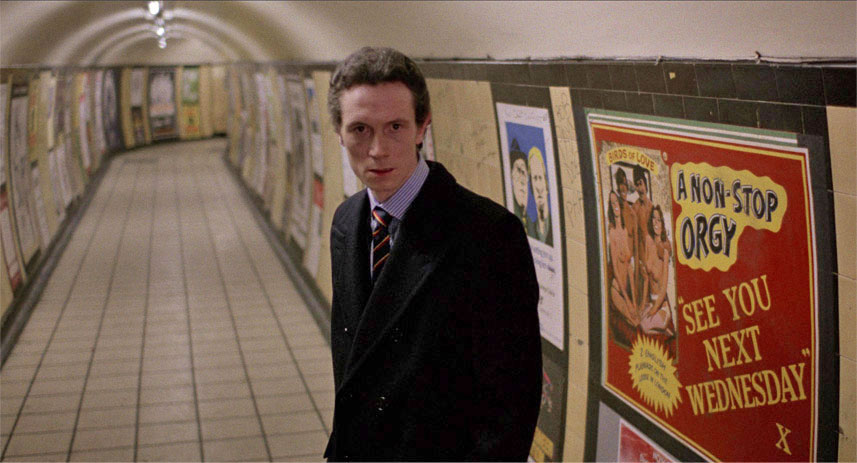
Now, then. The sound. You have a choice of original uncompressed 1.0 mono and optional 5.1 DTS-HD Master Audio tracks. Not knowing the extent of the restoration (do we still 'restore' or just scrub up films from the 80s?) it's always a coin toss – if the movie was recorded and mixed in mono – whether the 5.1 alternative is going to be a full re-mix or a desultory pass through a 'mono to 5.1 filter'. Once the disc menu appears, the room is bathed in a pleasing sub ambiance. If nothing else, the menu takes advantage of what 5.1 has to offer. The movie however gives the sub hardly anything to do, a slight bass bump on some of the standalone songs. But the savage attacks and wonderful sound design stay resolutely sub free while the rears are simple atmosphere tracks, very welcome to drop you in the middle of the story but it would have been nice to bring all six speakers into play at certain moments. To be fair, I played three of the major set pieces in both mono and 5.1 (not the whole movie) thinking if the mixer was going to kick in the sub, then these sequences would be the ones to showcase. Not a rumble heard. During the Piccadilly Circus sequence the rears are much more fully engaged with the atmospheres but where was the wonderful werewolf cry with attendant low frequencies? Considering how much I love this movie it's a small gripe. Don't we all scream blue murder if anyone so much as thinks of re-cutting a favourite film but somehow we always push for improved sound? There's some cognitive dissonance, right there.
There are optional subtitles for the deaf and hard of hearing.
New audio commentary by Beware the Moon filmmaker Paul Davis
When I heard Paul Davis say that to do a soft dolly shot on a road in the grey Brecon Beacons, the crew needed a Citroën Jeep owned by the brother-in-law of the first assistant director David Tringham, I was sold. Here was a man who revelled in the detail and if that can be appreciated by anyone it's Outsider. Some snippets which made me smile... Landis saw the Dangerous Brothers on stage (Rik Mayall and Ade Edmondson) and offered them both small roles in the film. I wonder why Edmondson didn't join in. The sound effect (the terribly convincing and mournful sound) of the wolf on the moor was an elephant roar played backwards with some reverberation added. Producers Peter Guber and Jon Peters thought it was way too violent and were actually repelled by it. They gave Landis notes to trim and lessen the gore. Landis went away for a fortnight, did absolutely nothing to the cut, re-showed it to the pair who were so initially disgusted and then said it was much better for its re-edit. Sheesh. Stuff like this seems to happen all the time in the business. On some mixing desks in British recording and dubbing studios there is a mixing knob known as 'the producer's fader'. If the producer wants more bass or treble, this fader is brought into play. The film unspools and the sound comes out. The producer says "More bass..." and the producer's fader is slowly pushed up... "A little more?" Pushed up further... "Yeah. That's it," says the producer unaware that the producer's fader is not wired up at all. The movie starts with a dedication to Jim O'Rourke, Landis's Schlock producer and friend who died of lung cancer. Landis thus forbade any smoking on set which some die-hard Brit crew smokers actually thanked him for. It proved a great incentive to kick the habit.
Paul Davis calls the shot of the Micky Mouse model inserted just before Rick Baker's first 'change-o-head' makes its appearance "... one of the most iconic edits in cinema." Hmmm. I'll give him 'iconic cutaway'. As well cut American Werewolf is by Malcolm Campbell, that's an iconic cutaway of necessity, a tool in the editor's arsenal. Nice to see Putney Bridge where I'm heading for a film crew reunion party on Saturday (too much information?). Davis' favourite scene in the porno theatre was apparently shot on the day he was born. Nice if not such a useful piece of trivia (like my reunion party). This is a brilliant commentary by someone with true passion and it's dripping with gems throughout.
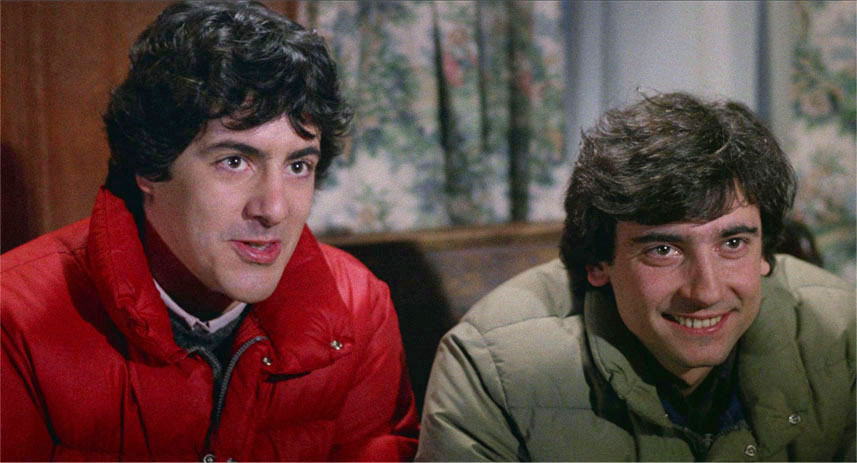
Audio Commentary by actors David Naughton and Griffin Dunne
It's clear the two still have an easy chemistry. Their memories are entertaining, irreverent and hugely satisfying. What it must be like for two mid-twenty something year olds, thirty-eight years later, to look back on themselves... The banter is essentially who they are so it's essentially the characters of David and Jack looking back on their adventures. As suspected Landis encouraged some ad-libbing and a great deal of the boys' banter got through. Some snippets; Naughton had a crush on Jenny Agutter from her role in Equus. Both men just "find ourselves just watching the film!" You can't blame them really. Dunne tells how ripped his make up off after hours of physical frustration which upset Baker. Of the transformation's first scene, Naughton says "There weren't a lot of takes because there weren't a lot of shirts!" He took just the one take to escape the wolves in the zoo. I could see why that was necessary. They were sniffing at parts no man can afford to lose. At the close, Dunne just chimes in with "So what time's dinner? I'll only stay a month." Lovely.
Mark of The Beast: The Legacy of the Universal Werewolf, newly produced, feature-length documentary by filmmaker Daniel Griffith, featuring interviews with John Landis, David Naughton, Joe Dante and more (1 hr 17' 17")
Landis tells the story of the origin of the movie in crisp black and white intercut with spruced up clips from The Wolfman from 1941. Lots of guests add their bit on the history and mythology of the narrative of lycanthropy. Apart from a shed load of clips, the interviews are presented very pleasingly in a letterboxed 2.35:1 aspect ratio with smoky transitions. The history of these horror icons is fascinating, one delivered by passionate chroniclers. There's also coverage of American Werewolf's effects and at last the debunking of Rob Bottin getting in first with The Howling when it came to transformation effects. Great to finally learn that Baker was on The Howling until American Werewolf got the green light so left it to Bottin. If you want a comprehensive introduction to the depiction of the werewolf in Hollywood then this is your one shop stop.
An American Filmmaker in London, a newly filmed interview with John Landis in which he reflects on his time working in Britain and British cinema (11' 41")
Landis reveals his love of global cinema and digs down into a broad appreciation of British cinema (Carry on films, Doctor films). He reveals that Hammer films were delivered to him mostly via the TV in the US. It's interesting that most of the Brat Pack (the six directors who emerged in the mid to late seventies of which Landis was not one) credited TV as their principal source of movie education. Landis gives a well-remembered and lovely celebration of his own crew. It's so nice that he was moved to acknowledge his team.

Wares of the Wolf, new featurette in which SFX artist Dan Martin and Tim Lawes of The Prop Store look at some of the original costumes and special effects artefacts from the film (7' 58")
Martin and Lawes go through presenting three main pieces of American Werewolf memorabilia; the pull-on Nazi mask for the nightmare family-murder scene; David's red puffer jacket, which in 1981 was something quite new and Rick Baker's first stage werewolf change-o-head. It's fascinating stuff. I remember a visit to Jim Henson's creature shop. As I walked past a very obvious, wires-out animatronic creature, an operator remote controlled the head and neck so that it followed me as I walked past. The effect was eerily lifelike despite the fact I could see it was a machine. Even the change-o-head divested of its latex and fur still has a powerful hold.
I Think He's a Jew: The Werewolf's Secret, new video essay by filmmaker Jon Spira (Elstree 1976) about how Landis' film explores Jewish identity (11' 24")
This is absolutely intriguing as a different take on the film in the way that the Kubrick Shining documentary 237 was not. The arguments put forward make a lot of sense and this sort of observation has a definite place on this disc. It's another way to think about how the movie was set up and what you may take away from it.
The Werewolf's Call, Corin Hardy, director of The Nun, chats with writer Simon Ward about their formative experiences with Landis' film (11' 26")
Two American Werewolf fan boys who happen to be filmmakers describe their exposure to the movie and how it's inspired both in their careers. They cover a director's vision and how the personality of the filmmaker informs the style of the film. If genres are mixed, it can still work based on the nature of its telling. I love Hardy's desire to see the film again after their chat. That's how film championing should work.
Beware the Moon, Paul Davis' acclaimed, feature-length exploration of Landis' film which boasts extensive cast and crew interviews (1 hr 37' 37")
Made ten years ago, this is a feature-length coverage of the history and cultural legacy of the film presented by Paul Davis as a visual accompaniment to his superb commentary. Some repetition with the commentary is inevitable. The playful dramatisations are less welcome though I do understand the temptation to do them. This is about the most comprehensive documentary I've seen on the film and is very welcome. Davis manages to cram in visits to most of the locations and crow bar in most of the top tier of talent involved in its making.

Making An American Werewolf in London, a short archival featurette on the film's production (05' 15")
"No movie is worth hurting someone for." That line of John Landis' in the promotional short may have been snipped for taste's sake perhaps? We get a good look at some of the make up secrets and a behind the scenes look at the shooting of the Piccadilly Circus carnage. Once a stuntman, Landis performs a modest window shattering and is judged with numbered cards, crap-TV style from the crew. Cute.
An Interview with John Landis, a lengthy archival interview with the director about the film (2201) (18' 19")
I know it can't be helped but here is even more repetition. I feel some editorial hand may be welcome but I guess the extras from outside sources have to stay complete? Less is certainly more when it comes to this sort of presentation. I cannot fault Arrow in its enthusiasm to provide everything that's available but once a joke's told, its power is diminished. If it's told again five minutes later... well, you get what I mean.
Makeup Artist Rick Baker on An American Werewolf in London, the legendary make-up artist discusses his work on the film (11' 13")
In 2001, Baker talks about Landis' first movie, Schlock and the genesis of how Werewolf's four-legged hound from hell came to be. He wanted the classic bi-pedal creature (compare with The Howling's wolves) but Landis overruled him. For what seems like the tenth time on this disc, Baker talks about the wet flap of flesh that draws your attention as Dunne delivers his lines. Baker had the idea of presenting the entire transformation in one shot (brave!) Even thinking about that now makes me think that was an insane ambition without complex camera moves to obscure certain 'behind the curtain' changes. I think the cut version was always going to work best. Nice to hear that audiences stood up and cheered the transformation on its first run.
I Walked with a Werewolf, an archival interview with the make-up artist about Universal horror and its legacy of Wolfman films (07' 30")
Baker in 2007 celebrating his love of monsters and how he is astounded that people to pay him to do what he is so passionate about. He talks about the transformation (the one shot idea) and the key to its success being time and money, enough to experiment, "...play and develop." He covers working on Universal's 2010 version of The Wolfman with Benicio del Toro and Anthony Hopkins.

Casting of the Hand, archival footage from Rick Baker's workshop as they cast David Naughton's hand (10' 59")
Ever since visual effects crept in and took huge bites out of what used to be taken care of by practical effects, the once desired information based on the question "How did they do that?" rarely comes without the mention of computer-generated effects. Now there is as much an art and skill in the older disciplines and here is a relatively short look almost in real time at what it takes to take a cast of the lead actor's hand so the fabulous Baker boys can weave some serious movie magic.
Outtakes (03' 07")
A curious bunch (Naughton falling over Landis, Landis posing with half transformed werewolf, inside the bus as it throws its occupants around, heads rolling, adding blood to Alex and the full size wolf puppet), all mute and ending on one of the first things shot, Landis making some sort of statement and then the walls crash behind him revealing the porn foursome starring in See You Next Wednesday, the porno they 'had' to shoot to project it into the penultimate scene.
Storyboard Featurette (02' 27")
Yup, those are storyboards, alright. A breakdown what was needed for the final action scene with corresponding live action sequence.
Original trailers, teasers and radio spots
Trailer (2' 53)
In the days it wasn't possible to examine a trailer, we have our monster front and centre with nary a hint at the transformation scene. No voiceover, just artfully cut carnage (a lot from the climax)
Teaser (1' 00")
A moon, a moon's reflection, a small channel of blood mixes with the moon's reflection and then a lot of noise and a splash!
TV Spot (0' 30")
A soft sell but a heavily edited but intriguing piece. If I was watching TV and this turned up, I'd be intrigued...
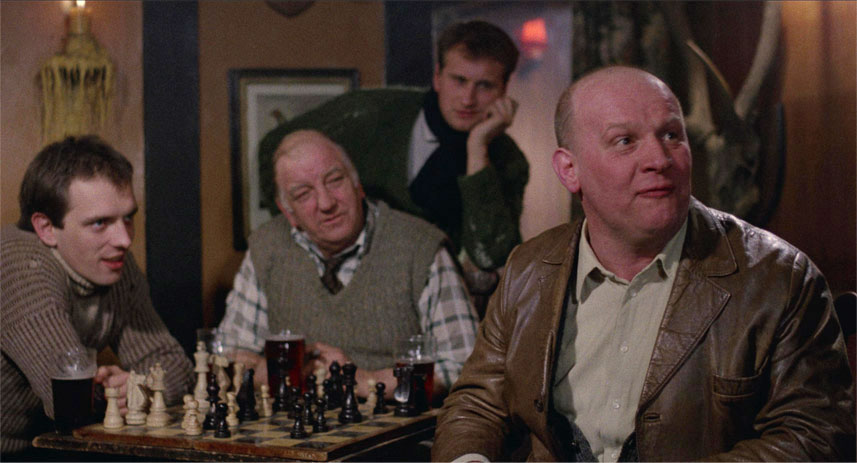
Extensive image gallery featuring over 200 stills, posters and other ephemera
Production Stills: 70 colour, 44 black and white stills chronologically presented. Behind The Scenes: 61 colour, 29 black and white. Posters: 8 English Posters (with that 7th a very subtle one of a shot of the UK with blood red sea with the werewolf's face taking a chunk out of Wales which is a antecedent of the subtlety of the poster for Ghost and the Darkness. Lobby Cards: 23 cards with no. 22 having to be seen to be believed. I'm not going to guess the language (Eastern) but it looks like the film is a bestial porn carry on movie! Lots of Nurse Price! Storyboards: John Bruno, the storyboard artist gets to have his introduction and then 25 x 2 boards of the main transformation (there were many deviations from the boards as you can imagine) and then a further 7 x 2 outlining his transformation in the cinema. This is fascinating as this was the scene as first written with the children at the cartoon cinema that Landis originally envisaged. It's interesting that the children just watch the proceedings, rapt! Presumably, they are all subsequently butchered in the script? Shooting Schedule: 8 pages shooting schedule, and 3 hand drawn maps of the Piccadilly Circus sequence lay out.
Physical Items not available for review include: Reversible sleeve featuring original poster art and artwork by Graham Humphreys, double-sided fold-out poster and six double-sided, postcard-sized lobby card reproductions
Also not available to review: Limited 60-page booklet featuring new writing by Travis Crawford and Simon Ward, archival articles and original reviews.
One of my favourites from the 80s, An American Werewolf In London has lost none of its ability to scare, or make me laugh after all these years. Only Rick Baker's own protégé Rob Bottin with his work on The Thing has come close to equalling what Baker managed on this film (The Thing was not of this world, a little more latitude with that, believability-wise). Baker made an animal we all know totally believable. If you've not seen the movie, you are in for a real scary treat. Beware the moon...
|